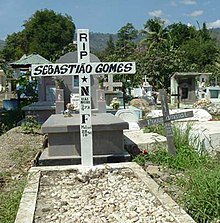Sebastião Gomes
Sebastião Rangel Gomes (born September 5, 1973 in Uai-Mori , Portuguese Timor , † October 28, 1991 in Dili , East Timor ) was an East Timorese independence activist. His memorial procession on November 12th, a week after his funeral, resulted in a demonstration for the independence of East Timor, which had been occupied by Indonesia since 1975 , which was forcibly disbanded by Indonesian security forces. At least 271 people died. With the international attention that the Santa Cruz massacre sparked, East Timor eventually achieved independence.
The death of Gomes
A visit by the Special Rapporteur on Torture Pieter Kooijmans and a delegation from the Portuguese Parliament was planned for November 1991 . Kooijmans should investigate reports of human rights abuses by various organizations. Expectations were high, especially as there were rumors that the delegation would meet with the prisoner independence leader Xanana Gusmão . The resistance movement prepared public protests beforehand. A group of young independence activists, including Gomes, painted banners for demonstrations in the grounds of the Church of Santo António de Motael . When the Indonesian security forces persecuted them, parish priest Alberto Ricardo da Silva offered them protection in the church. But at half past two in the morning security forces stormed the church and shot Sebastião Gomes, who then bled to death. Three bullets hit him. Two other Timorese were also shot injured. 30 of his colleagues were arrested, and 20 of them were released soon afterwards.
The funeral of Gomes in the Santa Cruz cemetery took place on November 5th, on November 12th the memorial march was to take place from the church of Motael to the cemetery, where flowers were to be laid on the grave. The delegation's visit had since been canceled, but Kooijmans was in Dili on November 11th, which is why the resistance movement wanted to take advantage of the memorial march for a demonstration. The demonstration remained peaceful and disciplined, but eventually Indonesian security forces attacked, dispersed, and arrested or killed many of the demonstrators. 270 people are still considered missing, which is why one can only speak of a minimum number of the official figure of 271 dead. As a result of the worldwide reporting, the pressure on Indonesia for a peaceful solution to the conflict increased. After the fall of the Indonesian dictatorship, there was an independence referendum in East Timor in 1999 , in which the clear majority of East Timorese spoke out in favor of independence. East Timor has been an independent state since 2002. The occupation from 1975 to 1999 cost at least 183,000 lives.
See also
Individual evidence
- ↑ a b TAPOL: The killing fields of Timor-Leste , December 1991 , accessed on November 12, 2016.
- ↑ epitaph
- ↑ a b "Chapter 7.2 Unlawful Killings and Enforced Disappearances" (PDF; 2.5 MB) from the "Chega!" Report of the CAVR (English)
- ↑ John Birmingham: Australia's Complicity in the East Timor Tragedy: Appeasing Jakarta ff, p 33, ISBN 1863953868
- ↑ Excerpts from the Testimony of Allan Nairn before the United States Senate Committee on Foreign Relations, February 27, 1992 , accessed February 5, 2013
| personal data | |
|---|---|
| SURNAME | Gomes, Sebastião |
| ALTERNATIVE NAMES | Gomes, Sebastião Rangel (full name) |
| BRIEF DESCRIPTION | East Timorese independence activist |
| DATE OF BIRTH | 5th September 1973 |
| PLACE OF BIRTH | Uai-Mori , Portuguese Timor |
| DATE OF DEATH | October 28, 1991 |
| Place of death | Dili , East Timor |

